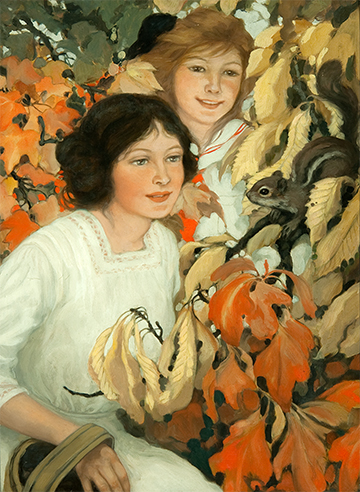An October Adventure in 1912

In 1912, Collier’s, a national weekly magazine, had a million subscribers. If we include family members and friends, and newsstand buyers and library patrons across the country, well over a million people lingered over the October 5 issue’s cover image of two vivacious young women delighted by a squirrel, while they are collecting acorns in the woods. Quite an audience for this snapshot of autumnal splendor and an unexpected forest adventure.
Katharine Richardson Wireman’s illustration immerses us in this fall outing. The women’s positions, one behind the other, create spatial depth even though the surrounding leaves encompass them both. It’s natural to look first at faces; then, we follow their gaze to discover the squirrel, almost camouflaged by foliage, its graceful tail curved against a dark gold leaf and its face framed against one of the pale-yellow serrated leaves. The colors and subject matter (human and animal) create an enticing magazine cover. The scene also lets us imagine a story. Is this a city park or a rural woodland? How long will the squirrel stay there before leaping away? Are these sisters? Maybe, but the two girls have distinctly individual features. They certainly have different reactions to the surprise encounter. The lively one in the background smiles broadly as she spots the squirrel. Her companion’s reaction is a little more subdued but equally absorbed. She bends down and leans forward but takes care not to move. Treasuring the moment, she wants to keep this creature nearby as long as possible. She smiles gently as the squirrel peers back. As they look at each other, there’s a sense of shared curiosity.
In 1912, popular magazine covers were many Americans’ only experience of art, and they were frequently framed. The published Collier’s cover did not do justice to Wireman’s composition, as both economics and printing technology limited magazines’ ability to reproduce colors faithfully. Still, the spirited mood, engaging narrative, and fall hues probably merited many frames.
Launched in 1888, Collier’s identified itself as a magazine of “fiction, fact, sensation, wit, humor, and news,” and became known for support of Progressive reforms. The magazine commissioned top-tier illustrators for their covers. Wireman joined an impressive group that included Charles Dana Gibson and Maxfield Parrish, as well as sought-after illustrators with now less-famous names.
By 1912, 34-year old Wireman had produced covers for The Saturday Evening Post, Good Housekeeping, and The Ladies’ Home Journal, among other major publications. At the time, attractive women were a staple of magazine covers. Editors believed that women were the main purchasers of the advertised goods that kept magazines afloat. Women, they reasoned, liked to see themselves (or the woman they aspired to be) reflected on covers. As was typical for most general interest publications, Collier’s targeted white readers of (or aspiring to join) the middle class.
Wireman knew that a Collier’s cover had to capture the attention of a wide range of working and stay-at-home women in American cities, suburbs, and rural communities, and of men everywhere alert to pictures of pretty girls. She brought both artistic training and life experience to each commission. After completing studies in her native Philadelphia with leading illustrator-teacher Howard Pyle in 1900, she spent five years in the competitive urban world of commercial illustration. For the next five years, she lived in Virginia’s Appalachian countryside, where her husband Henry had business interests. While there, she worked on advertising art commissions from companies such as Procter and Gamble. By 1910, when she began a three-year stint in New York with her family, she had a trained eye for natural scenery and contemporary styles.
City and country Collier’s readers could identify with an outdoor escapade, which looks as if it might be in one of the many beech-maple forests of the United States. Although Wireman was doubtless more interested in design than wildlife accuracy, readers could note the stripes and white eye ring of a ground squirrel, who tends to keep to lower tree branches. The girls’ clothing indicates good taste but not wealth. One wears the sporty middy blouse popular among young women. The other wears a blouse (or waist) of the inexpensive lightweight cotton, widely advertised at the time for leisure dress. Wireman adds the fashionable square “Dutch neckline.”
Parents might see their daughters on the cover. Young women could relate to the girls’ joy in nature and easy companionship. Some might feel nostalgia for the quiet refuge of the woods. Others might resolve to embark on a vigorous hike. Children might learn how not to frighten away little forest dwellers.
In this quintessentially October work of art, Katharine Richardson Wireman—with the poet Shelly—reminds us that “there is a harmony in autumn…which through the summer is not heard or seen.”





Thank you for this beautiful portrayal of Katherine Richardson Wireman.